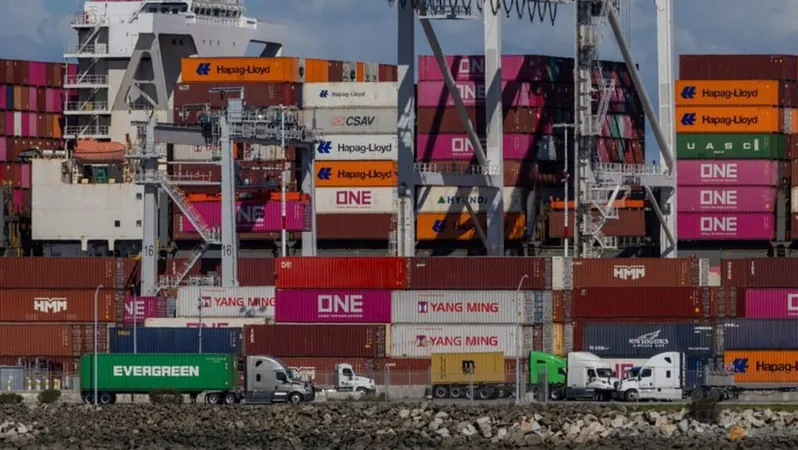
Trump's New 10% Tariff: A Shocking Move That Disrupts Global Trade Norms!
2025-04-05
Author: Wei Ling
Trump's 10% Tariff Implementation
On April 5, 2025, the United States began enforcing a significant 10% tariff on a wide array of imports from various countries, marking a bold shift from the traditional trade agreements established post-World War II. This unilateral decision by President Donald Trump aims to change the dynamics of international trade by imposing higher fees on goods coming from 57 major trading partners.
Immediate Economic Impact
The new tariff took effect at 12:01 AM Eastern Time, leading trade experts to describe it as potentially the 'biggest trade action of our lifetime.' Kelly Ann Shaw, a notable trade lawyer and former White House adviser, emphasized the monumental impact this will have on global trade relationships, stating expectations for future negotiations to amend these rates as nations scramble to adapt.
Stock Market Reactions
The stock market felt immediate repercussions from the announcement, with a staggering US$5 trillion wiped off the value of S&P 500 companies in just two days. As fears of an economic downturn spread, prices for oil and other commodities plummeted, prompting investors to seek refuge in government bonds.
Countries Affected
Countries including Australia, the UK, Brazil, Colombia, Argentina, and Saudi Arabia are among the initial targets of this tariff, despite many having trade deficits with the US last year. The White House contends that other nations would experience greater trade deficits with fairer policies.
Grace Period for Importers
Importantly, a US Customs and Border Protection bulletin allowed for a 51-day grace period for shipments already en route, providing until May 27 for cargoes loaded before the tariff's enactment to arrive without incurring charges.
Future Tariff Plans
The tariffs do not stop there. Plans for additional 'reciprocal' tariff rates range from 11% to a staggering 50% on specific imports, with the European Union facing a 20% tariff and China reeling under a dramatic 34%, raising its total to 54%. In response, Beijing has announced its own retaliatory measures, including additional tariffs on US goods and restrictions on rare earth mineral exports.
Political Reactions and Plans
Responding to the economic upheaval, Trump's social media comments expressed confidence in America's economic resilience, dubbing the situation an 'economic revolution.' Meanwhile, global leaders are dutifully reacting. French President Emmanuel Macron cautioned against the fallout of a trade war, advocating for unity to protect citizens and economies worldwide.
Diplomatic Talks
Plans for diplomatic talks are underway, with Israeli Prime Minister Benjamin Netanyahu due to meet with Trump to discuss a new 17% tariff affecting Israel and Japan's Prime Minister Shigeru Ishiba seeking an urgent conversation regarding a 24% tariff on Japanese goods.
Negotiations with Other Nations
As countries assess their strategies, Vietnam is seeking negotiations following a newly imposed 46% tariff on its exports. Taiwan's officials are also engaging with US representatives amidst fears of a 32% duty impacting their technology sector.
Exemptions from Tariffs
While Canada and Mexico remain exempt from these new tariffs, they still contend with existing duties under a North American trade agreement. Interestingly, Trump's order has excluded over 1,000 product categories—including essential items like pharmaceuticals and semiconductors—but the administration is contemplating further duties on these exemptions.
Future Implications of the Tariff Strategy
As the global trading landscape rapidly evolves in the wake of this bold tariff strategy, all eyes are on how nations will respond and negotiate a way forward. Will this mark the beginning of a new trade order, or will diplomatic discussions prevail in averting a global trade war? The coming weeks are sure to be pivotal in determining the future of international commerce.


 Brasil (PT)
Brasil (PT)
 Canada (EN)
Canada (EN)
 Chile (ES)
Chile (ES)
 Česko (CS)
Česko (CS)
 대한민국 (KO)
대한민국 (KO)
 España (ES)
España (ES)
 France (FR)
France (FR)
 Hong Kong (EN)
Hong Kong (EN)
 Italia (IT)
Italia (IT)
 日本 (JA)
日本 (JA)
 Magyarország (HU)
Magyarország (HU)
 Norge (NO)
Norge (NO)
 Polska (PL)
Polska (PL)
 Schweiz (DE)
Schweiz (DE)
 Singapore (EN)
Singapore (EN)
 Sverige (SV)
Sverige (SV)
 Suomi (FI)
Suomi (FI)
 Türkiye (TR)
Türkiye (TR)
 الإمارات العربية المتحدة (AR)
الإمارات العربية المتحدة (AR)